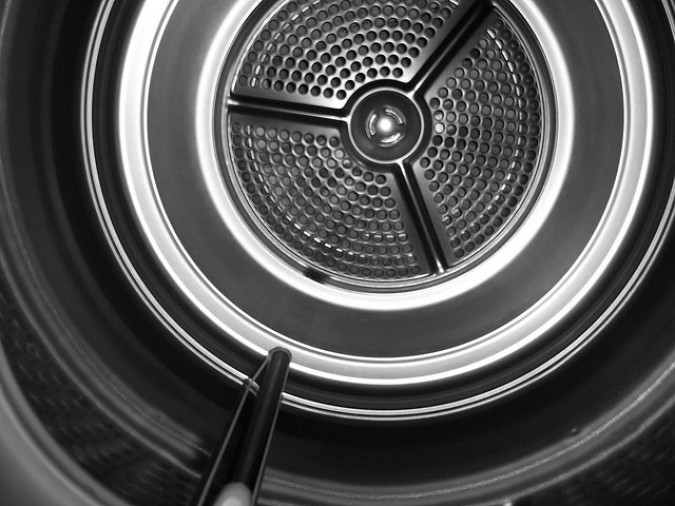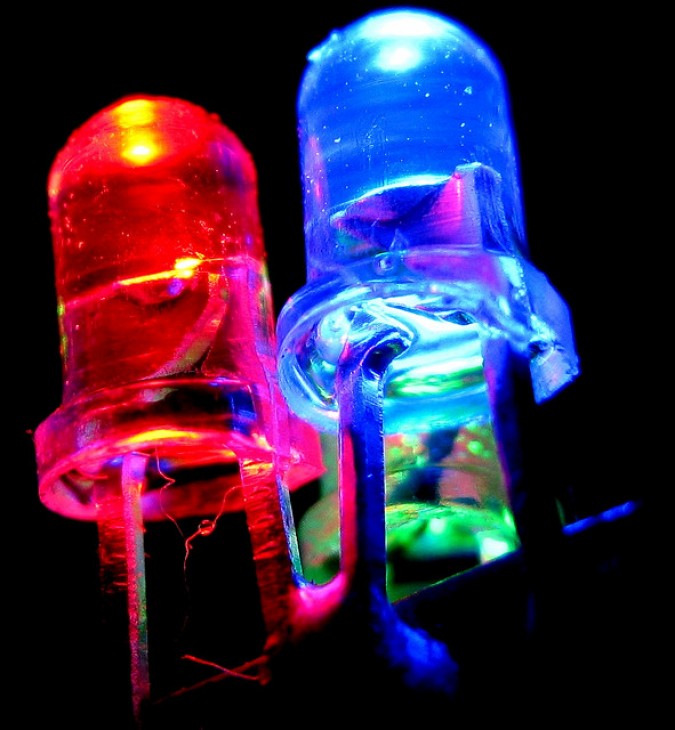Archive for the ‘patent’ tag
Heat recovering clothes dryer to heat water
July 24, 2011 when I was falling asleep I thought of an idea I love. I plan to try this idea in my bus conversion.
Here’s the idea:
Place a car radiator in the exhaust flow of a clothes dryer. Pump water or another heat exchange liquid through tubing that connects the radiator to a heat storage tank. The fluid in that tank will warm, and that warm water can be piped through hydronic floor heating piping to heat the home.
This heat recovery could be meaningful, especially in households where the dryer gets used a lot.
Alternatively or in addition, the recovered clothes dryer heat could heat the domestic hot water supply, and that water could be used for the clothes washer. In effect the heat from the dryer could make the washer more energy efficient.
Alternatively or in addition, the recovered clothes dryer heat could be used to heat an aquaponics fish tank, which generally makes the fish eat more and gain weight faster. I understand that catfish grow fastest when their water temperature is 84 degrees fahrenheit. It takes a lot of energy to warm hundreds of gallons of water, so recycling heat from a dryer is a good idea.
Car radiators are cheap. I discovered this when buying the parts to build my sound proof engine box for my bus conversion.
My idea is so simple and inexpensive. It’s applicable to gas and electric dryers, and it makes sense for nearly every home in every country I can think of that has a clothes dryer. Why hasn’t such a system already been implemented?
Others have conceived of capturing waste heat from clothes dryers. Inventor Richard A. Brunner patented in the United States a system that from my quick read of the full text of the patent uses a heat exchanger to warm house air with moist air from the dryer vent. I didn’t see anything about heating water or using the hot water to heat the house or the water for a clothes washer, as I have described.
I suspect all the major clothes dryer companies have also considered heat recovery systems. The idea is not far fetched. I believe many industrial factories capture ‘waste’ heat from systems all the time for use elsewhere.
As I understand it, home heating forced air furnaces of high efficiency already recover heat from the first combustion process in a so-called second stage. I have been told these super efficient furnaces are trouble prone, but that they do work. I was advised not to buy one due to their complexity. But these dual stage furnaces apparently work by burning the exhaust, not just capturing heat from it. My dryer heat recovery system would be much simpler and cheaper to construct.
I have read about devices to capture heat from waste drain water, which often contains heated water. I suspect the amount of heat those devices recover is relatively small compared to the available heat that could be cost effectively recovered from a clothes dryer.
When I converted my Kenmore natural gas clothes dryer to propane so I could install it in my bus conversion, I temporarily operated the dryer with the front cover removed. I got to see the flame size, and I would say it’s similar to the size of flame that would be produced by running four stovetop cooking burners at once.
Yes, a lot of the heat is consumed evaporating water, but when I put my hand over the outside vent when my dryer is running, it seems like at least as much heat as a 1,500 watt space heater produces.
I suspect about 2/3rds of that heat could be captured in a hot water tank. A space heater produces about 5,000 btus of heat per hour, so 2/3rds of 5,000 is 3,333 btus. It takes about 1,000 watts of electricity worth say USD $.20 to run 2/3rds of a 1,500 watt space heater. So the captured heat from running a dryer by electricity for an hour is worth about USD $.20.
If the dryer is run for five loads a week, a dollar a week in energy is saved, or $52 a year. A dryer might last for ten years, so $520 worth of energy would be saved over the life of the dryer, or enough money to pay for the entire appliance.
But energy is getting more costly, so over ten years the savings might be 50% higher.
Every little bit helps.
Gas water heaters and furnaces should also have heat exchangers installed in their exhaust stacks. If a house is built with the hydronic piping for these heat exchangers in place, the cost to add these recovery systems should be affordable. However, it would be much better to eliminate the water heater and furnace in most homes, in favor of mandatory solar water heating for water and the air.
I think it is one of mankind’s dumbest moves to ignore the sun for most water and home heating worldwide, in favor of burning fossil fuels which really should be saved for fueling aircraft and spacecraft and making advanced plastics.
Why are we not burning oil at a rate such that it will last for 1,000 years? Or 10,000 years? Some say we’ve used up half the oil on the planet already, in what, 150 years? That’s a snap of the fingers. What will we do in three snaps? Go back to sailing ships? Yes, by then we might figure out cold fusion or oil from algae such that it really substitutes for oil. But what if we don’t?
While I’m carrying on here, I should say that clothes dryers themselves are rather ridiculous when air drying clothes makes them last longer and is free. Garages should have enough clothes lines to dry multiple dryer loads of laundry, and garages should have fans that exhaust to the outside so that drying times can be reduced substantially. Outdoor clothes lines should be allowed everywhere, by law, in the same way that television satellite dishes are allowed everywhere in the United States by law. As I understand it, no contract can take away the right to install your own satellite dish. The exception is if you have free access to a community satellite dish.
Some housing complexes have legally enforceable covenants that forbid outdoor clothes lines, and your house can be foreclosed on and sold if you violate these contractual regulations. Such provisions should be against public policy and automatically be void and unenforceable.
Sadly, wet clothes don’t have the powerful lobby that the satellite television reception industry pays a lot of money to employ.
Apple patent pending for technology to block live event video capture
According to this Fox News story New Apple Technology Stops iPhones From Filming Live Events, Apple has filed a patent on technology to make it impossible to capture live video at protected live events.
The Fox News article explains the technology in a way that doesn’t make sense to me. I think what the article should have said is:
“A light emitting (LED) diode on stage at an event can blink in such a way as to alert the iPhone camera that recording is not allowed. The LED can emit invisible infrared radiation, so the audience won’t notice any difference in the event with their eyes.”
I am very suspicious of the Fox News technology explanation that says the iPhone will emit radiation that infrared sensors on stage will capture and react to. I think that’s implausible, because the iPhone would have to have a strong infrared LED in it, and over time that would diminish battery life. Also, it would mean the system would not work at long distances, such as stadium shows where the videographer might be a city block away. I don’t think LED remotes work over that distance. But a powerful infrared LED on stage could signal all the iPhones in the venue, and power usage wouldn’t be an issue because that LED could be plugged into AC power.
However it works, I applaud Apple for thinking their idea up. It’s a good and clever idea. I wish I had thought of it.
I think Apple could and should take this idea a few logical steps forward. Perhaps they have developed these plans but have not yet publicized them. I will detail my plans here, and if Apple should want to use them and they haven’t thought of them already, they can credit me and send me a new iPhone for life, as compensation.
1. Apple should not disable the capture of video. Instead it should offer to sell the user the ability to capture that event for a price, charged right there using Apple’s ‘in app’ purchase mechanism. This fee can be split with the venue and performer(s), using the same 70%/30% split people hate and love, respectively. The artists hate it and Apple loves it, I suspect. The video recorded should contain the serial number of the phone embedded into the video image in a way that is not visible to the eye but can be easily read by software. Then, if the video is posted online publicly, that user can be tracked down and charged more, perhaps even a lot more, to discourage them from doing it again. To make the serial number unremovable, it could float around the image from frame to frame, and change size and font. To take it out would take so much work as to be impractical.
2. Apple should apply this feature to all controlled access events, not just live events. Thus, this technology could be used in movie theatres to make it impossible to bootleg a movie being projected on screen. The phone could display a message offering the user the chance to buy the DVD and have it delivered the day it goes on sale, for example. It could offer the eager potential bootlegger the opportunity to ‘Like’ the movie on Facebook, building on the fan’s just demonstrated enthusiasm for the movie. Apple should resist any temptation to use the video attempt to turn the person over to the police, which it could do by having that phone call the police and use a recorded message to alert them that a Federal crime is in progress. Convicting fans is not good policy. Selling movies and related merchandise to avid fans is good policy.
3. Building on the last point, this technology could be used to prohibit video recording in airports, on nude beaches (with really bright LEDs on posts?), in bathrooms, locker rooms and even in private homes. If Apple’s technology could get incorporated into all video cameras, celebrities might worry a little less about being surreptitiously recorded in a compromising position.
While writing this post, it occurred to me that all audio recorders could incorporate similar technology, with similar benefits, as follows:
The audio feed for an event could contain an inaudible signal that the recorder could decode and act upon. The device could offer to permit recording for a fee, and the serial number of the device could be embedded inaudibly into the stream, to guard against public distribution. Or, for simpler devices like dictation recorders, the device could simply refuse to record.
This is generally how the old MacroVision anti piracy technology for VHS video tapes worked. A signal on the original didn’t disturb the picture when played back. But if you tried to record the signal to another VCR, that VCR would react to the signal and degrade the copy so much it was valueless.



